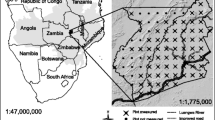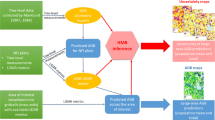Abstract
National greenhouse gas inventories often use variations of the gain–loss approach whereby emissions are estimated as the products of estimates of areas of land-use change characterized as activity data and estimates of emissions per unit area characterized as emission factors. Although the term emissions is often intuitively understood to mean release of greenhouse gases from terrestrial sources to the atmosphere, in fact, emission factors can also be negative, meaning removal of the gases from the atmosphere to terrestrial sinks. For remote and inaccessible forests for which ground sampling is difficult if not impossible, emission factors may be based on map-based estimates of biomass or biomass change obtained from regional maps. For the special case of complete deforestation, the emission factor for the aboveground biomass pool is simply mean aboveground, live-tree, biomass per unit area prior to the deforestation. If biomass maps are used for these purposes, estimates must still comply with the first IPCC good practice guideline regarding accuracy relative to the true value and the second guideline regarding uncertainty. Accuracy assessment for a map-based estimate entails comparison of the estimate to a second estimate obtained using independent reference data. Assuming ground sampling is not feasible, a map of greater quality than the regional map may be considered as a source of reference data where greater quality connotes attributes such as finer resolution and/or greater accuracy. For a local, sub-regional study area in Minnesota in the USA, the accuracy of an estimate of mean aboveground, live-tree biomass per unit area (AGB, Mg/ha) obtained from a coarser resolution, regional, MODIS-based biomass map was assessed using reference data sampled from a finer resolution, local, airborne laser scanning (ALS)-based biomass map. The rationale for a local assessment of a regional map is that, although assessment of a regional map would be difficult for the entire extent of the map, it can likely be assessed for multiple local sub-regions in which case expected local regional accuracy for the entire map can perhaps be inferred. For this study, the local assessment was in the form of a test of the hypothesis that the local sub-regional estimate from the regional map did not deviate from the local true value. A hybrid approach to inference was used whereby design-based inferential techniques were used to estimate uncertainty due to sampling from the finer resolution map, and model-based inferential techniques were used to estimate uncertainty resulting from using the finer resolution map unit values which were subject to prediction error as reference data. The test revealed no statistically significant difference between the MODIS-based and ALS-based map estimates, thereby indicating that for the local sub-region, the regional, MODIS-based estimate complied with the first IPCC good practice guideline for accuracy.

Similar content being viewed by others
References
Baccini A, Goetz SJ, Walker WS, Laporte NT, Sun M, Sulla-Menashe D, Hackler J, Beck PSA, Dubayah R, Freidl MA, Samanta S, Houghton RA (2012) Estimated carbon dioxide emissions from tropical deforestation improved by carbon-density maps. Nat Clim Change 2:182–185
Blackard JA, Finco MV, Helmer EH, Holden GR, Hoppus ML, Jacobs DM, Lister AJ, Moisen GG, Nelson MD, Riemann R, Ruefenacht B, Salajanu D, Weyermann DL, Winterberger KC, Brandeis TJ, Czaplewski R, McRoberts RE, Patterson PL, Tymcio RP (2008) Mapping U.S. forest biomass using national forest inventory data and moderate resolution information. Remote Sens Environ 112:1658–1677
Breidenbach J, Kublin E, McGaughey R, Andersen H-E, Reutebuch S (2008) Mixed-effects models for estimating stand volume by means of small footprint airborne laser scanner data. Photogramm J Finl 21(1):4–15
Breidenbach J, McRoberts RE, Astrup R (2016) Empirical coverage of model-based variance estimators for remote sensing assisted estimation of stand-level timber volume. Remote Sens Environ 173:274–281
Cochran WG (1977) Sampling techniques, 3rd edn. Wiley, New York, p 428
Corona P, Fattorini L, Franceschi S, Scrinz G, Torresan C (2014) Estimation of standing wood volume in forest compartments by exploiting airborne laser scanning information: model-based, design-based, and hybrid perspectives. Can J For Res 44:1303–1311
Duncanson L, Armston J, Disney M, Avitabile V, Barbier N, Calders K, Carte, S, Chave J, Herold M, Crowther T, Falkowski M, Kellner J, Labrière N, Lucas R, MacBean N, McRoberts RE, Meye, V Næsset E, Nickeson JE, Paul KI, Phillips O., Réjou- Méchain M, Román M, Roxburgh S, Saatchi S, Schepashenko D, Scipal K, Siqueira PR, Williams M, Whitehurst A. In review. The importance of global land product validation: towards a standardized protocol for aboveground biomass. Surveys in Geophysics. This issue
Efron B, Tibshirani R (1994) An introduction to the bootstrap. Chapman and Hall/CRC, Boca Raton
Fattorini L (2012) Design-based or model-based inference? The role of hybrid approaches in environmental surveys. In: Fattorini L (ed) Studies in Honor of Claudio Scala, Department of Economics and Statistics. University of Siena, Siena, Italy, pp 173–214
GFOI (2016) Integration of remote-sensing and ground-based observations for estimation of emissions and removals of greenhouse gases in forests: methods and guidance from the global forest observations initiative, 2nd edn. Food and agriculture organization, Rome 224 p.https://www.reddcompass.org/download-the-mgdAccessed July 2017
Hansen MH, Madow WG, Tepping BJ (1983) An evaluation of model-dependent and probability-sampling inferences in sample surveys. J Am Stat Assoc 78:776–793
Hansen M, DeFries R, Townshend JR, Carroll M, Dimiceli C, Sohlberg R (2003) 500 m MODIS vegetation continuous fields: tree cover. GLCF, University of Maryland, College Park
Huete A, Didan K, Miura T, Rodriguez E, Gao X, Ferreira L (2002) Overview of the radiometric and biophysical performance of the MODIS vegetation indices. Remote Sens Environ 83:195–213
IPCC (2006) 2006 IPCC guidelines for national greenhouse gas inventories, volume 4: agriculture, forestry and other land use. Eggleston HS, Buendia L, Miwa K, Ngara T, Tanabe K (eds). Published: Institute for Global Environmental Strategies, Japan. http://www.ipcc-nggip.iges.or.jp/public/2006gl/index.html. Accessed February 2018
Mauro F, Monleon VJ, Temesgen H, Ruiz LA (2017) Analysis of spatial correlation in predictive models of forest variables that use LiDAR auxiliary information. Can J For Res 47:788–799
McRoberts RE, Tomppo EO, Finley AO, Heikkinen J (2007) Estimating areal means and variances of forest attributes using the k-nearest neighbors technique and satellite imagery. Remote Sens Environ 111:466–480
McRoberts RE, Hansen MH, Smith WB (2010) United States of America. In: Tomppo E, Gschwantner T, Lawrence M, McRoberts RE (eds) National forest inventories, pathways for common reporting. Springer, Berlin 610 p
McRoberts RE, Næsset E, Gobakken T (2014) Estimation for inaccessible and non-sampled forest areas using model-based inference and remotely sensed auxiliary information. Remote Sens Environ 154:226–233
McRoberts RE, Chen Q, Domke GM, Ståhl G, Saarela S, Westfall JA (2016) Hybrid estimators for mean aboveground carbon per unit area. For Ecol Manag 378:44–56
McRoberts RE, Chen Q, Gormanson DD, Walters BF (2018a) The shelf-life of airborne laser scanning data for enhancing forest inventory inferences. Remote Sens Environ 206:254–259
McRoberts RE, Stehman SV, Liknes GC, Næsset E, Sannier C, Walters BF (2018b) The effects of imperfect reference data on remote sensing-assisted estimators of land cover class proportions. ISPRS J Photogramm Remote Sens 142:292–300
McRoberts RE, Næsset E, Gobakken T, Chirici G, Condés S, Hou Z, Saarela S, Chen Q, Ståhl G, Walters BF (2018c) Assessing components of the model-based mean square error estimator for remote sensing-assisted forest applications. Can J For Res 48:642–649
Mowrer HT, Congalton RG (eds) (2000) Quantifying spatial uncertainty in natural resources: theory and applications for GIS and remote sensing. Sleeping Bear Press, Ann Arbor
Olofsson P, Foody GM, Stehman SV, Woodcock CE (2013) Making better use of accuracy data in land change studies: estimating accuracy and area and quantifying uncertainty using stratified estimation. Remote Sens Environ 129:122–131
Olofsson P, Foody GM, Herold M, Stehman SV, Woodcock CE, Wulder MA (2014) Good practices for estimating area and assessing accuracy of land change. Remote Sens Environ 148:42–57
Pearson TRH, Brown S, Murra L, Sidman G (2017) Greenhouse gas emissions from tropical forest degradation: an underestimated source. Carb Balance Manag 12:3
Pelletier J, Kirby KR, Potvin C (2012) Significance of carbon stock uncertainties on emission reductions from deforestation and forest degradation in developing countries. For Policy Econ 24:3–11
Royall RM, Herson J (1973) Robust estimation in finite populations II. J Am Stat Assoc 68(344):890−893
Saarela S, Schnell S, Grafström A, Tutominen S, Nordkvist K, Hyppä J, Kangas A, Ståhl G (2015) Effects of sample size and model form on the accuracy of model-based estimators of growing stock volume. Can J For Res 45:1524–1534
Saatchi SS, Harris NL, Brown S, Lefsky M, Mitchard ETA, Salas W, Zutta BR, Buermann W, Lewis SL, Hagen S, Petrova S, White L, Silman M, Morel A (2011) Benchmark map of forest carbon stocks in tropical regions across three continents. Proc Natl Acad Sci 108:9899–9904
Särndal C-E, Swensson B, Wretman J (1992) Model assisted survey sampling. Springer, New York, p 694
Snedecor GW, Cochran WG (1967) Statistical methods, 6th edn. The Iowa State University Press, Lowa
Ståhl G, Saarela S, Schnell S, Holm S, Breidenbach J, Healey SP, Patterson PL, Magnussen S, Næsset E, McRoberts RE, Gregoire TG (2016) Use of models in large-area forest surveys: comparing model-assisted, model-based and hybrid estimation. For Ecosyst 3:5
Stehman SV (2009) Sampling designs for accuracy assessment of land cover. Int J Remote Sens 30(20):5243–5272
Vermote EF, Vermueulen A (1999) Atmospheric correction algorithm: spectral reflectances (MOD09). University of Maryland, College Park
Vogelmann JE, Howard S, Yang L, Larson C, Wylie B, Van Driel N (2001) Completion of the 1990s national land cover data set for conterminous United States from landsat thematic mapper data and ancillary data sources. Photogramm Eng Remote Sens 67:650–661
White D, Kimerling AJ, Overton WS (1992) Cartographic and geometric components of a global sampling design for environmental monitoring. Cartogr Geogr Inf Syst 19(1):5–22
Author information
Authors and Affiliations
Corresponding author
Additional information
Publisher's Note
Springer Nature remains neutral with regard to jurisdictional claims in published maps and institutional affiliations.
Rights and permissions
About this article
Cite this article
McRoberts, R.E., Næsset, E., Liknes, G.C. et al. Using a Finer Resolution Biomass Map to Assess the Accuracy of a Regional, Map-Based Estimate of Forest Biomass. Surv Geophys 40, 1001–1015 (2019). https://doi.org/10.1007/s10712-019-09507-1
Received:
Accepted:
Published:
Issue Date:
DOI: https://doi.org/10.1007/s10712-019-09507-1




